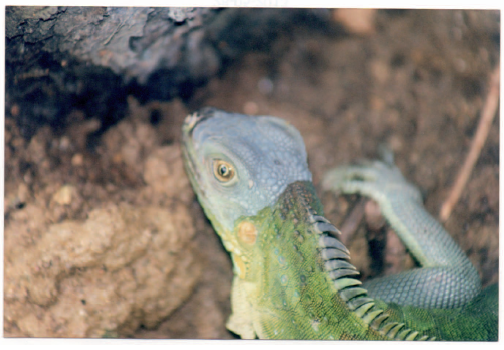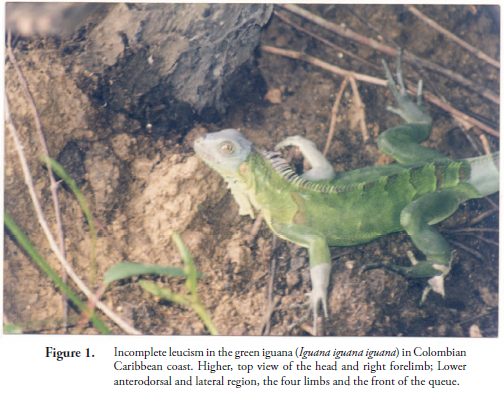Services on Demand
Journal
Article
Indicators
-
 Cited by SciELO
Cited by SciELO -
 Access statistics
Access statistics
Related links
-
 Cited by Google
Cited by Google -
 Similars in
SciELO
Similars in
SciELO -
 Similars in Google
Similars in Google
Share
Boletín Científico. Centro de Museos. Museo de Historia Natural
Print version ISSN 0123-3068
Bol. Cient. Mus. Hist. Nat. Univ. Caldas vol.18 no.1 Manizales Jan./June 2014
SHORT COMMUNICATION
A REPORT ON A CASE OF INCOMPLETE LEUCISM IN THE GREEN IGUANA (Iguana iguana iguana) (SQUAMATA: IGUANIDAE) IN THE CARIBBEAN COLOMBIAN*
REGISTRO DE UN CASO DE ALBINISMO INCOMPLETO EN LA IGUANA VERDE (Iguana iguana iguana) (SQUAMATA: IGUANIDAE) EN EL CARIBE COLOMBIANO
Rosa Mary De Ayala-Monedero1, Ricardo Álvarez-León2
* FR: 4-III-2014. FA: 30-III-2014.
1 Estación Experimental de Zonas Áridas. Consejo Superior de Investigaciones Científicas. Almería (España). deayala@eeza.csic.es
2 Fundación Verdes Horizontes. Manizales (Caldas) Colombia. E-mail: ricardoalvarezleon@gmail.com
CÓMO CITAR: DE AYALA-MONEDERO, R.M. & ÁLVAREZ-LEÓN, R., 2014.- A report on a case of incomplete leucism in the green iguana (Iguana iguana iguana) (Squamata: Iguanidae) in the Caribbean colombian. Bol. Cient. Mus. Hist. Nat. U. de Caldas, 18 (1): 158-162.
Abstract
Objectives: To complement the fauna associated with mangrove estands inventory in the Colombian Caribbean. Scope: Qualitative and quantitative inventory of specimens observed. Methodology: Direct observation,specific annotations and photographs of specimens. Main results:For the first time a copy of the green iguana (I. i. Iguana) with partial leucismo associated with mangro vestands (bobo or conchudo, Laguncularia racemosa and piñuelo or zaragoza, Conocarpus erecta) from the Colombian Caribbean coast is recorded. Conclusions: Despite therelative intensityof sampling and observations about iguanas, this finding represents an important advance in the knowledge of the family Iguanidae and, genera Iguana in Colombia.
Key words: green iguana, leucismo incomplete, mangroves, Caribbean, Colombia.
Resumen
Objetivos: Complementar el inventario de fauna asociada a los rodales de manglar del Caribe colombiano. Alcance: Inventario cualitativo y cuantitativo de los ejemplares observados. Metodología: Observación directa, anotaciones específicas y fotografía de los ejemplares. Principales resultados: Se registra por primera vez un ejemplar de la iguana verde (I. i. iguana) con leucismo parcial, asociada a rodales de manglar (bobo o conchudo, Laguncularia racemosa y piñuelo o zaragoza, Conocarpus erecta) de costa Caribe de Colombia. Conclusiones: A pesar de la relativa intensidad de los muestreos y observaciones sobre iguanas, este hallazgo representa un importante avance en el conocimiento de la familia Iguanidae y el género Iguana en Colombia.
Palabras clave: iguana verde, leucismo parcial, manglares, Caribe, Colombia.
Coloration in reptiles, as in other poikilothermic vertebrates, is determined by chromatophores (BECHTEL, 1995). One of the different kinds of these cells are the guanophores, and the lack of the guanine pigment in these specific cells is the cause of the albinism arising. Complete albinism is expressed as a lack of integumentary and retinal melanin, however, true albinos can exhibit integumentary coloration due to the other types of chromatophores: xanthophores and iridophores (CLARK, 2002).
Another colour aberration, the leucism, describes specimen with reduced or absent integumentary pigment, but with pigmented retinas (BECHTEL, 1995). This term is more commonly used in the herpethological literature and considered to be the more correct definition in the majority of the cases (SCHMIDT, 1999; CLARK, 2002).
Knowledge of reptiles and amphibians albinism occurrence has been summarized by HENSLEY (1959) and subsequently by DYRKACZ (1981). Nevertheless, the majority of the reported species belongs to the Neartic region and is mostly snakes. Reports for tropical lizards are still rare, having the contribution of PÉREZ-HIGAREDA (1980), regarding a species of the iguanid Corytophanes hernandezi as one of the few publications done.
Between February and July 1996, the fauna inventories made in the Colombian Caribbean mangroves, were focused on the birds (these results are summarized in DE AYALA (1997a, 1997b, 1997c). These observations were almost opportunistic because they dependent on the work the biologists-technicians group was making on the vegetation all along the Caribbean continental coast. Some of the inspections were made by using boat whistling methods along the coast, but the majority of the species were recorded by using standardized census methods (i.e. transects and trapping).
The green iguana specimen was observed the 14th July 1996, in the "Playa de los Holandeses" (11º 16' N - 73º 19' W) (Guajira, Colombia), 500 m from the mouth of the Jerez River, surrounded by floors with loamy silts, very dilute (salinity of 0 ups and pH of 6.5), as well as mangroves sweet, "bobo or conchudo" (Laguncularia racemosa) with heights from 8-18 m and diameters 21-40 cm, "blacks or zaragoza" (Conocarpus erecta) of 4-6 m height and diameters 20-24 cm. (Fig. 1).
The associate vegetation is composed by "aguacatillos" (Persea sp.), "bejucos lecheros" (Rhabdadenia biflora), "helechos cola de gallo" (Acrostichum aureum), "malváceas" (Hibiscus tiliaceus), "manzanos de playa" (Hipopomane mancinella), "clemones" (Thespesia populnea) and "arbustos espinosos" (Caesalpinea sp.).
The characteristic "biche" green coloration of iguanas that inhabit the mangroves and its influence areas, was clearly stumped by a white grayish tone throughout the abdomen area, as well as in the head, the fan gular, the previous dorsal thorns (1-31) and in the final thorms (50-end of the line), in both hands and its digits, in the arms and in both feet and its digits; the stomach was white uniform.


Intensive surveys have been made in the Santa Marta region for several years by MULLER (1968, 1969a, 1969b, 1971), has studied the iguanas and other reptiles, describing many aspects of their biology; HERNÁNDEZ-CAMACHO et al. (1980), ÁLVAREZ-LEÓN (1993), the peculiarities of mangrove ecosystems and, BEJARANO –MORENO & ALVAREZ-LEON (2003, 2006), inventories of the fauna associated with the different ecosystems of the region river, estuarine and marine, especially associated with emergent vegetation.
Many other researches and campaigns have been made in favour of the Green Iguana in the Colombian Caribbean Coast, but there were no evidence of this kind of alteration. The are only some reports of this color aberration in reptiles among the few registration done in the Colombian territory, one of them was made by SANCHEZ-PÁEZ et al. (2000) about the Boa constrictor, snake with an uncommon coloration pattern in specimens in the San Andres, Providencia and Santa Catalina Islands specimenes. They also describe malanism exhibit by some males of the Gonatodes albogularis liard. Albino boas have been reared by Sergio MEDRANO-BITAR (pers. comm.) in a zoo nursing, because they have a high demand in the international market. This is also happening with leucistic and albinos animals which are becoming a common attraction in zoos and also common pets, eventhoug they are not common in the wild. That is why this paper provides the first report of leucism in the Green Iguana within the continental Caribbean.
Recently, RODRÍGUEZ-PINILLA & GOMEZ-MARTINEZ (2011) also reported a case of leucism incomplete in common blackbird (Turdus fuscater) of the Colombian Andes, which confirms that wild species is rare chromatic alterations are poorly common and usually genetic origin (ACOSTA, 2005) and that mutations can cause interference with the expression of the type and concentration of melanin (BUCKLEY, 1982).
Funding was provided by the Project PD 171/91 Rev.2 (F) Fase 1. "Conservación y Manejo para el Uso Múltiple y Desarrollo de los Manglares en Colombia" (Ministerio del Medio Ambiente / Organización Internacional de Maderas Tropicales). Additional financial assistance was given to RMDA by Idea Wild Equipment Donation and Conservation International and further logistical aid by Association CALIDRIS and Universidad del Valle (Cali, Colombia).
BIBLIOGRAFÍA
ACOSTA, L., 2005.- Primer caso conocido de leucismo parcial en Tiaris olivacea en Cuba. Huitzil, 6: 14-15. [ Links ]
ÁLVAREZ-LEÓN, R., 1993.- Mangrove Ecosystems in Colombia, pp. 75-113 In: LACERDA, L. D. (ed.) Conservation and Sustainable Utilization of Mangrove Forest in Latin America and Africa Regions, ITTO / ISME Project PD 114/90 (F). ISME-Tech. Reports (2), [ Links ] 272 p.
BECHTEL, H. B. 1995. -Reptiles and amphibian variants: colors, patterns, and scales. Krieger Publishing Co. Malabar (Fla.) USA, 206 p. [ Links ]
BUCKLEY, P.A., 1982.- Avian genetics, pp. 21-110 In: PETRAK, M. (ed.) Diseases of cage and aviary birds. Second edition. Lea and Febiger. Philadelphia (USA). [ Links ]
CLARK, S., 2002.- First report of albinism in the white-spotted bamboo shark, Chiloscyllium plagiosum (Orectolobiformes: Hemiscyllidae), with a review of reported color aberrations in elasmobranchs. Zoo Biology, 21: 519-524. [ Links ]
DE AYALA-MONEDERO, R. M., 1997a.- Inventario de la avifauna de los manglares del Caribe colombiano. Proy. PD 171/91 Rev. 2 (F) Fase I. Conservación y Manejo para el Uso Múltiple y el Desarrollo de los Manglares de Colombia, MMA / OIMT. Santa Fe de Bogotá D. C. (Colombia). Inf. Técnico, 16: 1-24. [ Links ]
DE AYALA-MONEDERO, R. M., 1997b.- Avifauna asociada a los manglares del Caribe continental colombiano. Anexo 10 pp. 504 - 506 In: Sánchez-Páez, H. & R. Álvarez-León (eds.). Diagnóstico y Zonificación Preliminar de los Manglares del Caribe de Colombia. Proy. PD 171/91 Rev. 2 (F) Fase I MMA / OIMT. Santa Fe de Bogotá D. C. (Colombia), 511 p. [ Links ]
DE AYALA-MONEDERO, R. M., 1997c.- Inventario de aves en los manglares del Caribe colombiano. Tesis Profesional. Fac. de Ciencias. Univ. del Valle. [ Links ]
DYRKACZ, S., 1981.- Recent Instances of albinism in North American amphibian and reptiles. Society for the study of amphibian and reptiles. Herpetological Circular, 11: 31 p. [ Links ]
HENSLEY, M. M., 1959.- Albinism in North American amphibians and reptiles. Publications Museum Michigan State University, Biological Series, 1 (4): 133-159. [ Links ]
HERNÁNDEZ-CAMACHO, J. I., VON HILDEBRAND, P. & ÁLVAREZ-LEÓN, R., 1980.- Problemática del manejo de manglares con especial referencia al sector occidental de la Ciénaga Grande de Santa Marta, Magdalena, Colombia, pp.364-386 In: M. VEGAS-VÉLEZ (ed.) Mem. Est. Cientif. e Imp. Hum. en el Ecosist. Manglar, UNESCO / UNIVALLE. Cali (Valle) Colombia, nov. 27-dic. 1º de 1978, 405 p. [ Links ]
MORENO-BEJARANO, L. M. & R. ÁLVAREZ-LEÓN., 2003.- Fauna asociada a los manglares y a otros humedales en el Delta-Estuario del Río Magdalena, Colombia. Rev. Acad. Colomb. Cienc., 27 (105): 517-534. [ Links ]
MORENO-BEJARANO, L. M. & R. ÁLVAREZ-LEÓN., 2006.- Nuevos registros de la fauna asociada a los diferentes ecosistemas de la Ciénaga Grande de Santa Marta. [ Links ]
UDC- Luna Azul (Rev. Cientif., - Versión On Line), 23: 21-22. [ Links ]
MULLER, H., 1968.- Untersuchungen über Wachstum und Altersverteilung einer Population des Grünen Leguans Iguana iguana iguana L. (Reptilia: Iguanidae). Mitteilugen aus dem Instituto Colombo-Alemán Investigaciones Científicas Punta de Betín, 2: 57-65. [ Links ]
MULLER, H., 1969a.- Okophysiologische und Okethologische Untetrsuchungen an Cnemidophorus lemniscatus L. und Iguana iguana L. (Reptilia: Tejidae und Iguanidae) in Kolumbien. Dissertation Universitate Muster, 85 p. [ Links ]
MULLER, H., 1969b.- Okophysiologische und Okethologische Untetrsuchungen an Cnemidophorus lemniscatus L. (Reptilia: Tejidae) in Kolumbien. Forma et Funtio, 4: 189-224. [ Links ]
MULLER, H., 1971.- Okologische und Ethologische Studien an Iguana iguana L. (Reptilia: Iguanidae). Zoologische Beitrage, N. F., 18: 109-131. [ Links ]
PÉREZ-HIGAREDA, G., 1980.- Albinism in Corytophanes hernandezi (Lacertilia: Iguanidae). Bulletin Maryland Herpetological Society, 16 (3): 97-98. [ Links ]
RODRÍGUEZ-PINILLA, Q. & GÓMEZ-MARTÍNEZ, M. J., 2011.- Leucismo incompleto en Turdus fuscater (Passeriformes: Turdidae) en los andes colombianos. Bol. Cient. Mus. Hist. Nat., 15 (1): 63-67. [ Links ]
SÁNCHEZ-PÁEZ, H., G. A. ULLOA-DELGADO, R. ÁLVAREZ-LEÓN, W. O. GIL-TORRES, A.S. SÁNCHEZ-ALFÉREZ, O. A. GUEVARA-MANCERA, L. PATIÑO-CALLEJAS & F. E. PÁEZ-PARRA., 2000.- Hacia la recuperación de los manglares del Caribe de Colombia, pp. 1-294 In: H. SÁNCHEZ-PÁEZ, G. A. ULLOA-DELGADO & R. ÁLVAREZ-LEÓN (eds.) Proy. PD 171 / 91 Rev. (F) Fase II (Etapa II) Conservación y Manejo para el Uso Múltiple y el Desarrollo de los Manglares en Colombia, MMA / ACOFORE / OIMT. Santa Fe de Bogotá D. C. 294 p. [ Links ]
SCHMIDT, W.R., 1999.- Hemachatus haemachatus Rinkhals. Leucism. African Herpethological News, 29: 38-39. [ Links ]













